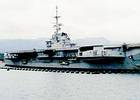 法國總統席哈克19日展開對印度的國事訪問,兩國領袖於21日簽署雙邊協定,未來將在民生用核能發電、太空、能源、觀光及軍購領域進行合作。但席哈克總統此次的訪問,差一點因法國退役航空母艦「克里蒙梭號」準備被送往印度拆卸,而蒙上一層陰影──幸而這計畫已在15日喊停。
法國總統席哈克19日展開對印度的國事訪問,兩國領袖於21日簽署雙邊協定,未來將在民生用核能發電、太空、能源、觀光及軍購領域進行合作。但席哈克總統此次的訪問,差一點因法國退役航空母艦「克里蒙梭號」準備被送往印度拆卸,而蒙上一層陰影──幸而這計畫已在15日喊停。
法國總統席哈克根據法國最高行政法庭裁決結果,於15日下令克里蒙梭號航空母艦返回法國水域待命。法院此番裁決是針對綠色和平組織提出的申訴案,因綠色和平組織認為,船艦所含有的石綿與有毒物質數量與官方數據不符,而且船艦拆解作業將對印度帶來健康與環境方面的危險。
法國綠色和平組織執行長杭斯汀表示:「這是對環境的大勝利,也是我們和其他組織動員反對此事的大成果。」綠色和平組織要求法國應該自行處理該國的有毒廢棄物,而非運往印度;因為在印度,拆船業者管理不良,常讓受雇工人暴露在有毒廢棄物環境中。
杭斯汀解釋:「我們認為法國將一艘充滿石綿、多氯聯苯、鉛、水銀等有毒化學物的廢棄戰艦丟在印度,在每天有貧工傷亡的廢料場等待徒手拆解,這件事真是大錯特錯。而法國則堅持沒錯,還是把船送到印度去。」
自從1997年克里蒙梭艦在法國土倫除役以來,她像是沒人要的足球一樣被踢來踢去許多年。
2001年,原本試圖將她鑿沉在地中海人造暗礁的計畫中斷,因環境當局表示該船上的石綿數量不利礁石。
2003年時,土耳其拒絕拆解該船,同時一家德國拆船公司原本打算在義大利清除船上可見的石綿,卻因為花費預算過高而失敗。希臘也拒絕讓她進入國境內進行類似作業。
克里蒙梭艦目前在返航法國途中。
綠色和平在聲明中表示:「克里蒙梭一案已經成為富有國家丟棄有毒廢料在貧窮國家的不公義象徵。法國一次又一次的嘗試都失敗,無法把船艦廢棄物丟給他國,最後,法國終究要自行善後,為這些自己製造的有毒物質負起責任。」
綠色和平組織表示每年「一大群充滿有毒物質、石綿、多氯聯苯和重金屬等危險物質的廢棄船艦,在孟加拉、印度、中國和巴基斯坦的拆船工廠終結壽命。這些地區的拆船作業常是以『以最粗糙的手法拆船』,而人類的健康和地方環境則要付出龐大的代價。」
French President Jacques Chirac began a state visit to India Sunday, and today signed bilateral agreements for civilian nuclear cooperation, space, energy and tourism, with military hardware deals expected in the future. But Chirac's visit was nearly overshadowed by controversy over the Clemenceau, an obsolete French aircraft carrier on its way to India for shipbreaking - until February 15.
On February 15, President Chirac ordered the Clemenceau to return to French waters and remain on standby following a ruling by France's highest administrative court, the Conseil d'État. The court acted on a complaint from Greenpeace regarding discrepancies in the amount of asbestos and other toxics present in the ship, which Greenpeace argued would pose a health and environmental hazard in India.
"This is a huge victory for the environment, and for the campaign headed up by us and other organizations," said Greenpeace France executive director Pascal Husting. Greenpeace demanded that France should deal with its own toxic waste instead of shipping it to India, where workers employed in a poorly managed shipbreaking industry would be exposed to toxic waste.
Husting explained, "We said it was wrong for France to dump a 27,000-ton warship full of asbestos, PCBs, lead, mercury, and other toxic chemicals in India to be broken up by hand in a scrapyard where impoverished workers are injured and die every day. France insisted it was right and sent the ship to India anyway."
Since the Clemenceau was decommmissioned in Toulon, France in 1997 it has been kicked around like a football no one wants.
In 2001, attempts to scuttle the ship as an artificial reef in the Meditarranean failed when environmental authorities said the amount of asbestos onboard was unsuitable for a reef.
In 2003, Turkey refused to accept the ship for shipbreaking, and in addition, a German ship broker was unsuccessful in his attempt to remove visible asbestos from ship in Italy when costs skyrocketed. Greece refused to allow the ship to enter for decontamination.
The Clemenceau is now on its way back to France.
"The case of the Clemenceau has become a symbol of the moral injustice of rich countries dumping their toxic waste on poorer countries. Having tried and failed to offload the ship to other countries to avoid responsibility for the toxic mess of its own making, France has finally been forced to clean up its own act," the group said in a statement.
Greenpeace says that every year "a vast decrepit armada bearing a dangerous cargo of toxic substances, asbestos, PCBs and heavy metals, ends up in ship breaking yards in Bangladesh, India, China, and Pakistan. Shipbreaking in these areas involves ships being "cut up in the crudest of fashions, taking a huge toll on human health and the local environment."




